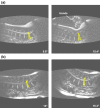Segmental lumbar mobility in individuals with low back pain: in vivo assessment during manual and self-imposed motion using dynamic MRI
- PMID: 17261197
- PMCID: PMC1794409
- DOI: 10.1186/1471-2474-8-8
Segmental lumbar mobility in individuals with low back pain: in vivo assessment during manual and self-imposed motion using dynamic MRI
Abstract
Background: Altered spinal mobility is thought to be related to current or past episodes of low back pain; however evidence of that relationship in younger subjects has not been established. The purpose of this study was to compare lumbar segmental mobility in asymptomatic and symptomatic subjects during posterior to anterior (PA) manual spinal mobilization and a self-initiated prone press-up (PU) maneuver. We hypothesized that persons with central low back pain would have an altered lumbar segmental mobility pattern compared to those without pain.
Method: Forty-five individuals (age 32.1 +/- 8.5) with non-specific low back pain and 20 persons (age 31.1 +/- 7.0) without low back pain participated. Each subject underwent dynamic imaging of the lumbar spine during a PA mobilization procedure and while performing a PU. Segmental motion was quantified as the change in the intervertebral angle between the resting and end-range vertebral positions.
Results: The symptomatic group had a larger percentage of subjects with evidence of single level segmental hypermobility than the asymptomatic group during the PA (40.0% vs. 5%) and PU (26.7% vs. 15%) procedures. Single lumbar motion-segment analysis revealed hyper-mobility in symptomatic subjects at L5 - S1 (Chi-square = 10.0, p < or = 0.01) and L4 - L5 (Chi-square = 4.18, p < or = 0.05) during the PA test.
Conclusion: Persons with non-specific low back pain have a tendency to demonstrate single level lumbar segmental hypermobility when compared to age specific asymptomatic subjects.
Figures




Similar articles
-
The relationship between lumbar segmental motion and pain response produced by a posterior-to-anterior force in persons with nonspecific low back pain.J Orthop Sports Phys Ther. 2005 Apr;35(4):203-9. doi: 10.2519/jospt.2005.35.4.203. J Orthop Sports Phys Ther. 2005. PMID: 15901121
-
Intertester reliability and validity of motion assessments during lumbar spine accessory motion testing.Phys Ther. 2008 Jan;88(1):43-9. doi: 10.2522/ptj.20060179. Epub 2007 Nov 20. Phys Ther. 2008. PMID: 18029394
-
Assessment of lumbar spine kinematics using dynamic MRI: a proposed mechanism of sagittal plane motion induced by manual posterior-to-anterior mobilization.J Orthop Sports Phys Ther. 2004 Feb;34(2):57-64. doi: 10.2519/jospt.2004.34.2.57. J Orthop Sports Phys Ther. 2004. PMID: 15029938
-
Spinal PA movements behave 'as if' there are limitations of local segmental mobility and are large enough to be perceivable by manual palpation: A synthesis of the literature.Musculoskelet Sci Pract. 2018 Aug;36:25-31. doi: 10.1016/j.msksp.2018.04.005. Epub 2018 Apr 16. Musculoskelet Sci Pract. 2018. PMID: 29680511 Review.
-
The reliability of video fluoroscopy, ultrasound imaging, magnetic resonance imaging and radiography for measurements of lumbar spine segmental range of motion in-vivo: A review.J Back Musculoskelet Rehabil. 2023;36(1):117-135. doi: 10.3233/BMR-210285. J Back Musculoskelet Rehabil. 2023. PMID: 35988213 Review.
Cited by
-
Lumbar facet joint motion in patients with degenerative disc disease at affected and adjacent levels: an in vivo biomechanical study.Spine (Phila Pa 1976). 2011 May 1;36(10):E629-37. doi: 10.1097/BRS.0b013e3181faaef7. Spine (Phila Pa 1976). 2011. PMID: 21270686 Free PMC article.
-
[Spinal form and function profile: reference values for clinical use in low back pain].Orthopade. 2014 Sep;43(9):841-9. doi: 10.1007/s00132-014-2316-0. Orthopade. 2014. PMID: 24838982 German.
-
Regional differences in lumbar spinal posture and the influence of low back pain.BMC Musculoskelet Disord. 2008 Nov 18;9:152. doi: 10.1186/1471-2474-9-152. BMC Musculoskelet Disord. 2008. PMID: 19014712 Free PMC article.
-
Analysis of translation and angular motion in loaded and unloaded positions in the lumbar spine.N Am Spine Soc J. 2020 Nov 20;4:100038. doi: 10.1016/j.xnsj.2020.100038. eCollection 2020 Dec. N Am Spine Soc J. 2020. PMID: 35141606 Free PMC article.
-
Segmental lumbar rotation in patients with discogenic low back pain during functional weight-bearing activities.J Bone Joint Surg Am. 2011 Jan 5;93(1):29-37. doi: 10.2106/JBJS.I.01348. J Bone Joint Surg Am. 2011. PMID: 21209266 Free PMC article.
References
-
- Guzman J, Esmail R, Karjalainen K, Malmivaara A, Irvin E, Bombardier C. Multidisciplinary bio-psycho-social rehabilitation for chronic low back pain. Cochrane Database Syst Rev. 2002:CD000963. - PubMed
-
- Frank JW, Kerr MS, Brooker AS, DeMaio SE, Maetzel A, Shannon HS, Sullivan TJ, Norman RW, Wells RP. Disability resulting from occupational low back pain. Part I: What do we know about primary prevention? A review of the scientific evidence on prevention before disability begins. Spine. 1996;21:2908–2917. doi: 10.1097/00007632-199612150-00024. - DOI - PubMed
-
- Frank JW, Brooker AS, DeMaio SE, Kerr MS, Maetzel A, Shannon HS, Sullivan TJ, Norman RW, Wells RP. Disability resulting from occupational low back pain. Part II: What do we know about secondary prevention? A review of the scientific evidence on prevention after disability begins. Spine. 1996;21:2918–2929. doi: 10.1097/00007632-199612150-00025. - DOI - PubMed
Publication types
MeSH terms
LinkOut - more resources
Full Text Sources
Medical
Miscellaneous

